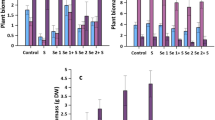Abstract
Two experiments were conducted to study the effect of the application of selenium on the selenium content of soybean and its products in two counties with selenium-deficient soil. Selenium-enriched soybean was produced by the application of sodium selenite and Se-enriched fertilizer. The selenium contents of soybeans, soybean protein and okra were determined by hydride-generation atomic fluorescence spectrometry. The results showed that the selenium contents of soybean, soybean protein, and okra were significantly increased by the application of sodium selenite and selenium-enriched fertilizer. Foliar application of selenium provided a higher efficiency for increasing the selenium content of soybean than soil application. Significant differences were found in that soybean cultivars exhibited different accumulation of selenium. There was no remarkable difference in soybean yield, soybean protein, and lipid between selenium and control. The selenium-enriched protein derived from selenium-enriched soybean could be used as a functional ingredient and soybean okra as a selenium-enriched feed for animals for increasing selenium intake.
Similar content being viewed by others
References
C. Rellly, Selenium: a new entrant into the functional food arena, Trends Food Sci. Technol. 9, 114–118 (1998).
K. Ge and G. Yang, The epidemiology of selenium deficiency in the etiology of endemic diseases in China, Am. J. Clin. Nutr. 57, 259–263 (1993).
C. Ip, Lessons from basic research in selenium and cancer prevention, J. Nutr. 128, 1845–1854 (1998).
J. X. Lu, H. Y. Pei, C. Ip, D. J. Lisk, H. Ganther, and H. J. Thompson, Effect of an aqueous extract of selenium-enriched garlic on in vitro markers and in vivo efficacy in cancer prevention, Carcinogenesis 17, 1903–1907 (1996).
J. W. Finley, The absorption and tissue distribution of selenium from high-selenium broccoli are different from selenium sodium selenite, sodium selenate, and selenomethionine as determined in selenium-deficient rats, J. Agric. Food Chem. 46, 3702–3707 (1998).
Q. H. Hu and J. C. Zhu, Biological geochemistry and selenium in food chain, Rural Ecoenviron. 16, 54–57 (2000).
J. P. Dia-Alarcón, M. Navarro-Alarcón, Herminis López, Garcia de la Serrana, and Maria C. López-Martinez, Determination of selenium levels in vegetables and fruits by hydride generation atomic spectrometry, J. Agric. Food Chem. 42, 2848–2851 (1994).
M. Eurola, P. Ekholm, M. Ylinen, P. Koivistoinen, and P. Varo, Effect of selenium fertilization on the selnium content of cereal grains, flour, and bread produced in Finland, Cereal Chem. 67, 334–337 (1990).
U. C. Gupta and S. C. Gupta, Selenium in soils and crops, its deficiencies in livestock and humans: implication for management, Commun. Soil Sci. Plant Anal. 31, 1791–1807 (2000).
Q. H. Hu, L. C. Chen, J. Xu, Y. Hu, Y. L. Zhang, and G. X. Pan, Determination of selenium concentration in rice and the effect of foliar application of Se-enriched fertilizer or sodium selenite on the selenium content of rice, J. Sci. Food Agric. 82, 869–872 (2002).
M. Stadlober, M. Saner, and K. J. Irgolic, Effects of selenate supplemented fertilization on the selenium level of cereals—identification and quantification of selenium compounds by HPLC-ICP-MS, Food Chem. 73, 357–366 (2001).
L. C. Chen, F. M. Yang, Q. H. Hu, and G. X. Pan, Selenium content of various foods and nutritional evaluation of selenium levels for Nanjing inhabitants, Food Sci. 21, 57–58 (2000) (in Chinese).
J. Neve, New approaches to assess selenium status and requirement, Nutr. Rev. 58, 363–369 (2000).
M. Friedman and D. L. Brandon. Nutritional and health benefits of soy protein, J. Agric. Food Chem. 49, 1069–1086 (2001).
S. K. Sathe, April C. Mason, R. Rodibaugh, and C. M. Weaver, Chemical form of selenium in soybean (Glycino max L.) lectin, J. Agric. Food Chem. 40, 2084–2091 (1992).
K. J. Helzlsouer, H. Y. Huang and A. J. Alberg, Association between α-tocopherol, γ-tocopherol, selenium, and subsequent prostate cancer, J. National Cancer Institute 92, 2018–2023 (2000).
N. Peng, F. J. Gong, G. L. Wang, and X. J. Wu. The analysis of the glycine’s selenium quantity and the study of the existing state of selenium in Hubei province, Natural Product Research and Development 9, 40–41 (1997).
L. C. Chen, F. M. Yang, J. Xu, Y. Hu, Q. H. Hu, Y. L. Zhang, and G. X. Pan, Determination of selenium concentration of rice in China and the effect of fertilization of selenite and selenate on selenium content of rice, J. Agric. Food Chem. 50, 5128–5130 (2002).
J. P. Dia-Alarcón, M. Navarro-Alarcón, H. López-Garcia de la Serrana, C. Asensio-Drima, and M. C. López-Martinez, Determination and chemical speciation of selenium in farmlands from southeastern Spain: Relation to level found in sugar cane, J. Agric. Food Chem. 44, 2423–2427 (1996).
V. Poggi, A. Arcioni, P. Filippini, and P. G. Pifferi, Foliar application of selenite and selenate to potato (Solanum tuberosum): Effect of a ligand agent on selenium content of tubers, J. Agric. Food Chem. 48, 4749–4751 (2000).
K. Yasumoto, T. Suzuki, and M. Yoshida, Identification of selenomethionine in soybean protein, J. Agric. Food Chem. 36, 463–467 (1988).
J. F. Sun, S. M. Xie, Z. J. Wang, and A. Peng; Selenium distribution in soybean components (Chinese), Acta Ecologica Sinica 16, 397–401 (1996).
Z. J. Wang, Distribution of Se in soybean samples with different Se concentration, J. Agric. Food Chem. 44, 2754–2759 (1996).
Q. Y. Guo, Z. Y. Li, and X. Q. Zhen, Genotype difference in selenium accumulation of soybean, Chin. J. Oil Crop Sci. 19, 69 (1997).
Author information
Authors and Affiliations
Rights and permissions
About this article
Cite this article
Yang, F., Chen, L., Hu, Q. et al. Effect of the application of selenium on selenium content of soybean and its products. Biol Trace Elem Res 93, 249–256 (2003). https://doi.org/10.1385/BTER:93:1-3:249
Received:
Accepted:
Issue Date:
DOI: https://doi.org/10.1385/BTER:93:1-3:249




